Title of paper under discussion
A filled duration illusion in music: Effects of metrical subdivision on the perception and production of beat tempo.
Authors
Bruno H Repp and Meijin Bruttomesso
Journal
Advances in cognitive psychology vol. 5 114-34, 13 January 2010
Link to paper (free access)
Overview
Scientists have long recognised that a “filled” time interval is perceived as longer than an “empty” one of identical duration, a phenomenon known as the filled duration illusion (FDI).
A classic way of filling a time interval, or a beat, is by metrical subdivision; for instance if a metronome is beating out a pulse of crotchets (quarter-notes) then subdividing it into quavers (8th-notes) ‘fills’ each beat with an extra note; and subdividing it into semiquavers (16th-notes) ‘fills’ each beat with an extra three notes.
Bruno Repp [a towering figure in timing research] and Meijin Bruttomesso set out to investigate if a subdivided beat did indeed seem to last longer than a ‘clean’ beat; and if so, whether performing musicians (and non-musicians) rushed the subdivisions in order to ‘correct’ the tempo.
Section one (pp114-122) details experiments that involved listening to a metronome before tapping out its pulse. The researchers discovered that when asked to tap a subdivided pulse (e.g. quavers) at the same tempo of a clean pulse (in crotchets) just preceding it, participants invariably tap too fast. And when listening to a clean pulse followed by a subdivided pulse participants invariably judged the subdivided pulse as sounding slower than the clean one of the same tempo.
In section two (pp122-130) Bruno Repp turned a stopwatch to his, and Yale University’s, extensive record collection to see if famous pianists ‘rush’ the (subdivided) first variation after an (un-subdivided) theme in Beethoven piano sonatas, finding that they nearly always did. He even composed short pieces with subdivided elements to see if musicians rushed those subdivisions (they did), and if listeners judged subdivided beats as “slower” than surrounding clean beats of the same tempo (again they did).
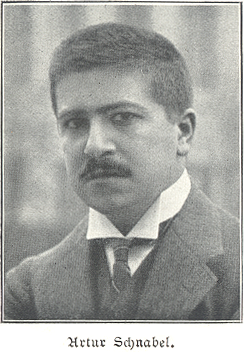
Section one – Metronome experiments
Repp and Brutomesso used three experimental designs to investigate the ‘filled duration illusion’ using a metronome pulse:
1. “Continuation tapping” whereby in each trial the participant a) taps along to a metronome pulse and then b) continues to tap – at what they judge to be the same tempo – after the metronome has been switched off.
2. “Reproduction tapping” in which the participant a) listens (without tapping) to a metronome pulse then b) after the metronome is switched off tries to reproduce that tempo exactly by tapping.
3. “Perceptual judgement” in which the participant a) listens to one pulse then b) listens to another and tries to judge whether the second is slower than, same as or faster than the first.
In each of these designs the second half of the trial involved either subdividing or not subdividing. So, for instance, in ‘continuation tapping’ the participant, once the metronome was switched off, had to continue tapping either in the clean pulse or in a subdivided pulse. In ‘reproduction tapping’ the participant had to reproduce the metronome beat either by tapping out a clean pulse or by tapping out a subdivided pulse. And in the ‘perceptual judgement’ task the second pulse presented to the participant was either clean or subdivided.
[These designs complemented a study Repp had carried out two years earlier in which all the subdivided options were in the first half of each trial. He decided that moving them to the second half brought the investigation closer to real music, where composers tend to bring in subdivisions only once a clean pulse has been established}
The results nearly all pointed to the existence of a filled duration illusion, causing participants (musicians and non-musicians alike) to tap a faster pulse when making subdivisions compared with when making none, and meaning that “a subdivided comparison sequence had to be faster than a simple standard sequence to be judged as having the same beat tempo”.
One interesting little anomaly was that triplet subdivisions in the “continuation” task were actually played slower than the ‘clean’ pulse (at least when the clean pulse was relatively slow itself), whereas the duplet subdivisions were, as predicted, always played at a quicker pulse. [Repp calls it “a mystery to be resolved” but offers some ideas on p120, first para]
Section two – musical excerpts
Keen to discover if their findings could be “generalised to real music performance”, Repp measured “the tempo of the theme and first variation in commercial recordings of two Beethoven piano sonatas that contain movements in variation form”: Sonata in F minor (Appassionata), op 57 and Sonata in C minor, op 111.
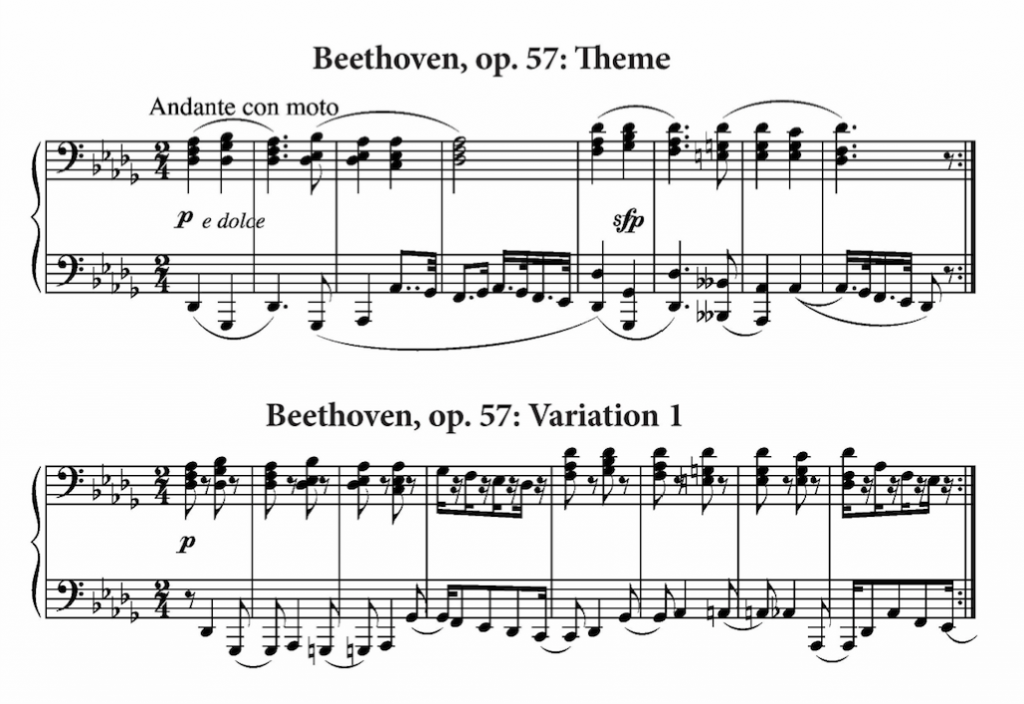
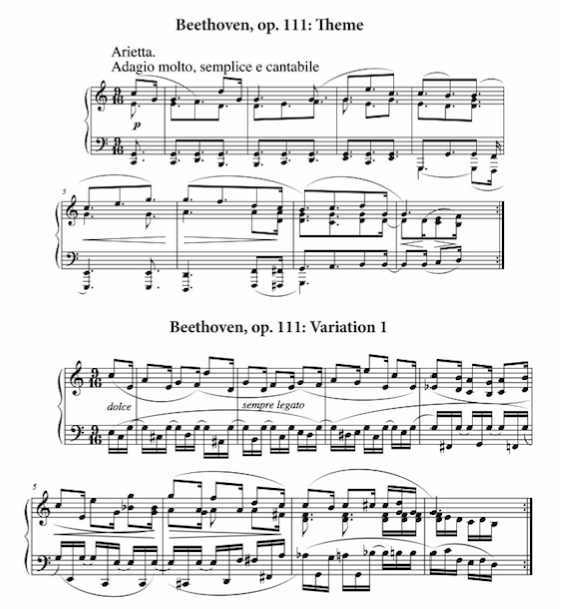
Listening to 28 different performances of op 57 and 32 of op 111 whilst observing the second hand of his wristwatch, Repp calculated the “mean inter-beat interval (IBI)” – i.e. the average duration of each beat, an inverse measure of tempo – of a) the theme and b) the first variation in each recording. He plotted the results here:
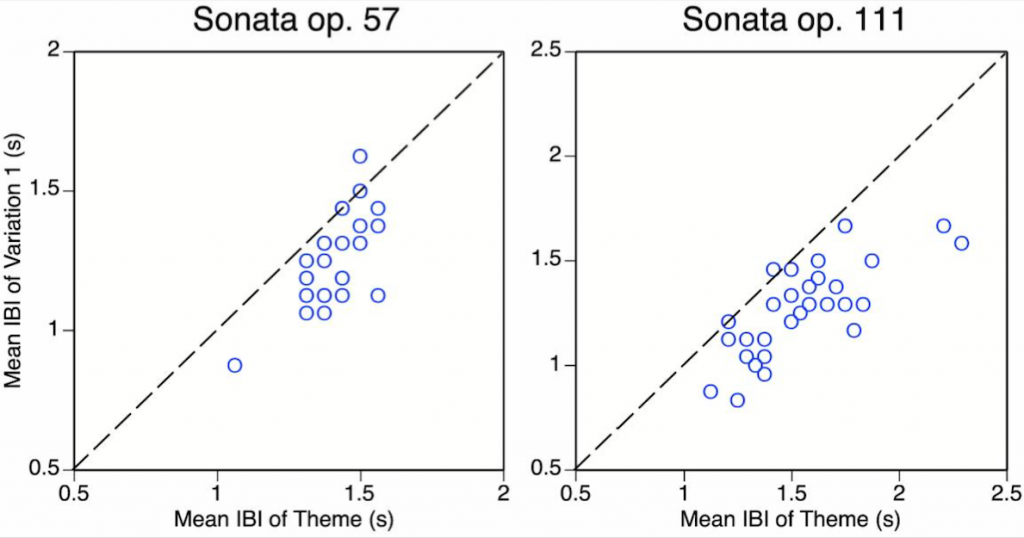
With the dotted line representing equality of tempo between theme and first variation it is clear that nearly all performers have a lower IBI – i.e. a quicker tempo – in the first variation compared with the theme.
Some pianists are identified as accelerating only to the extent (under 5%) predicted by the “filled duration illusion”, or “FDI”: Gilels, Yves Nat, Pollini and Artur Rubinstein in op57, and Gulda, Pollini, Rudolf Serkin and Solomon in op 111.
However the authors note that the hike in tempo is usually even larger than “the modest change predicted by the FDI hypothesis” – up to 28% in op 57 and 34.9% in op 111, whereas FDI alone would predict an increase of under 5%.
Beethoven does not indicate any tempo change for the first variation, and the authors conclude that “most of the observed accelerations presumably reflect more or less conscious artistic decisions”.
Artur Schnabel is singled out for this quote: “The feeling of one central tempo for the entire work must be maintained, especially when a composer increases the motion from one variation to the next, as Beethoven does both in the Appassionata, op. 57, and in the Sonata in C minor, op. 111. Their point is lost if the speed changes at all.” And yet it is Schnabel who showed “the largest acceleration of all pianists in op 111 (34.9%) and the second-largest in op 57 (22.7%)”.
Repp declares “It can only be concluded that [Schnabel] considered himself exempt from following his own teachings”. Later in the paper Repp recalls a Mozart recital by Marc-André Hamelin in which semiquavers were always accelerated (to ‘piquant’ effect), leading him to surmise that “the tendency to speed up in busier music may be more or less intentional amplification of an obligatory tendency fomented by the FDI”.
To finish off the investigations, Repp composed some short single-line piano pieces containing clean and subdivided beats, with the subdivided beats either in blocks:
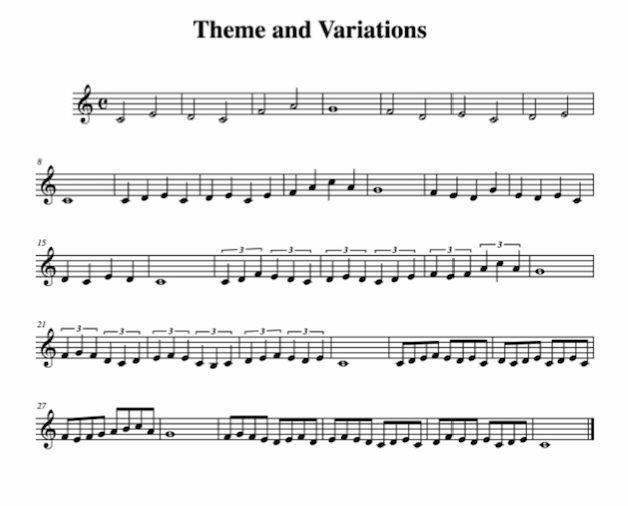
or nestled within bars (measures):
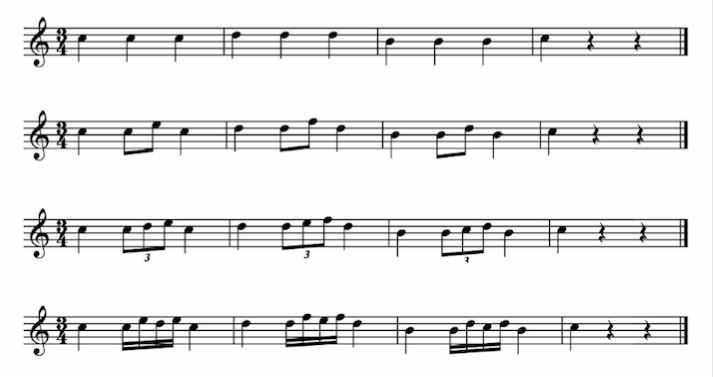
Participants (all musicians) were asked to perform the works “at a constant tempo throughout”. When tempo fluctuations within each performance were investigated it transpired (from the first composition) that subdivided beats were accelerated, and (from the second composition) that this acceleration effect also spread to neighbouring ‘clean’ beats. And just as in the ‘perception’ tasks in Section One, a computer-generated performance of the second composition needed accelerated subdivisions in order to sound ‘even tempo-ed”, although listeners turned out to be amazingly tolerant to compression or expansion of subdivisions. Intriguingly too, the size of the subdivision – duplets, triplets, quadruplets – was independent of the size of the FDI.
Discussion
“Why does the FDI occur?” The authors make clear that this study does not set out to address that question, but their preferred hypothesis seems to be that “continuous or intermittent auditory input during an interval accelerates an internal pacemaker that emits pulses that are transmitted to an accumulator that measures interval duration in terms of pulse counts”.
The paper’s final paragraph is worth quoting in full:
“The implications of the present findings for music performance may be more far-reaching than was first thought. Initial findings merely suggested that musicians would have to play music containing more notes slightly (unnoticeably) faster in order to compensate for the subjective slowing of such passages. However […] the measurements of Beethoven sonata performances indicate that accelerations in real performance are often much larger than would be required to compensate for the FDI. The FDI thus may merely be the germ of a more pervasive tendency to accelerate in dense passages, which musicians sometimes try to avoid but at other times seem to follow quite happily, probably because they find it expressively appropriate. A simple and intuitively reasonable argument, compatible with the pacemaker acceleration hypothesis, is that a high auditory event rate increases arousal, and that musicians want to communicate their heightened excitement to listeners, thereby exaggerating the subdivision effect that would be predicted by the FDI alone.”
Coda
Beethoven – Piano Sonata in F minor (Appassionata), op 57 (2 mvt is from 9:08)
Piano – Artur Schnabel